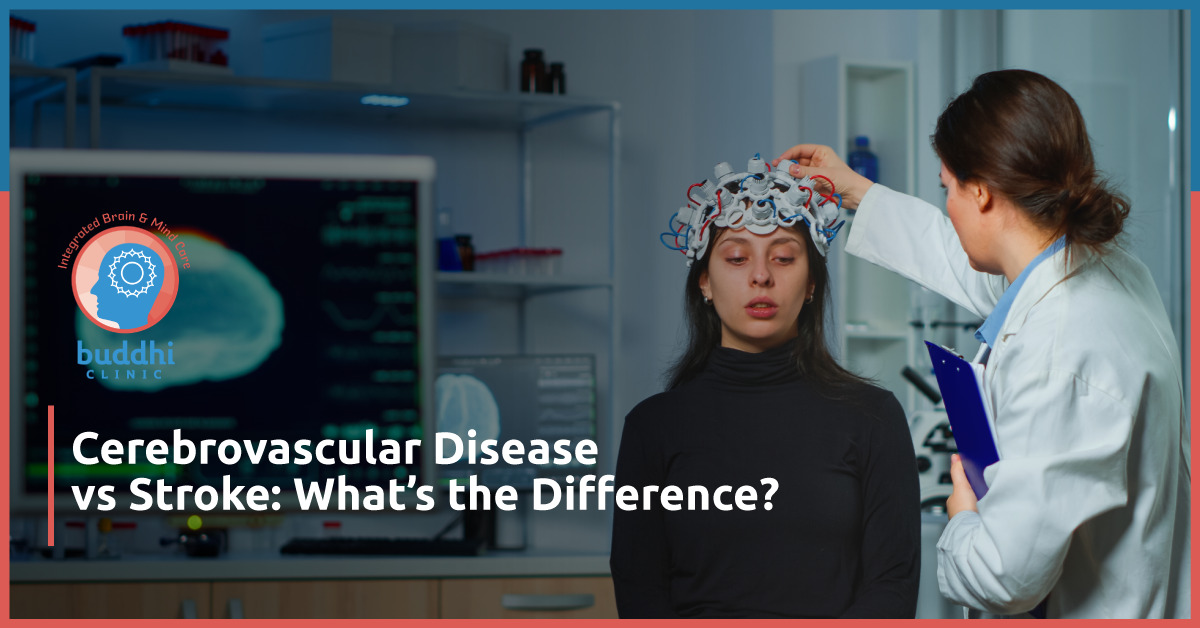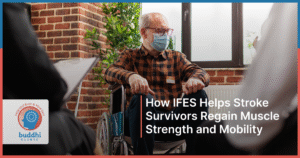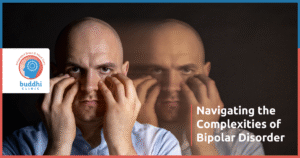Introduction
Cerebrovascular disease vs stroke are among the world’s top causes of death and disability. Although the two conditions impact brain blood flow, they differ in aetiology, symptoms, and management. Knowing the differences between cerebrovascular disease and stroke can enable people to identify warning signs, obtain early medical attention, and avoid long-term complications.
Cerebrovascular disease is a collection of disorders that affect brain blood vessels, resulting in reduced blood and oxygen supply. Stroke, however, is an abrupt, life-threatening condition in which the blood supply to a portion of the brain is interrupted, resulting in brain cell death.
This blog discusses the distinction between cerebrovascular disease vs stroke, its risk factors and symptoms, and the cutting-edge treatment available at Buddhi Clinic to aid individuals in their recovery and maintenance of vascular health.
What Is Cerebrovascular Disease?
Cerebrovascular disease is the general name given to diseases that involve blood vessels that supply the brain. When these arteries become occluded, stenosed, or compromised, it can lead to decreased blood supply to the brain and raise the risk of stroke.
Common Forms of Cerebrovascular Disease
There are a variety of disorders encompassed under cerebrovascular disease, such as:
- Stroke: Most frequent type, resulting from a blocked or haemorrhaging blood vessel.
- Transient Ischemic Attack (TIA): Brief blockage, sometimes referred to as a “ministroke.”
- Brain Aneurysm: A weakened blood vessel that can burst and bleed in the brain.
- Carotid Artery Disease: Artery narrowing that delivers blood to the brain, risking stroke.
- Arteriovenous Malformation (AVM): A tangled mass of blood vessels interfering with circulation.
Causes of Cerebrovascular Disease
The major cause of cerebrovascular disease is vascular dysfunction, which results in inadequate blood circulation within the brain. Contributory factors are:
High blood pressure (hypertension): One of the leading causes of stroke and vascular disease.
Diabetes: High glucose levels harm blood vessels, which raise the risk of blood clots and blockage.
High cholesterol: Leads to the formation of plaque in arteries, narrowing blood supply.
Smoking: Weakened blood vessels and speeds up vascular disease.
Obesity & inactive lifestyle: Bad circulation and high blood pressure lead to vascular disorders.
Symptoms of Cerebrovascular Disease
Symptoms of cerebrovascular disease take time to develop and can be:
- Dizziness or loss of balance
- Memory loss or cognitive impairment
- Trouble speaking or understanding words
- Sudden vision impairment
- Persistent headache or weakness
Because cerebrovascular disease develops over a period of years, early detection and treatment are critical to prevent stroke.
What Is a Stroke?
A stroke results from an interruption of blood supply to the brain, cutting off oxygen and nutrition for brain cells. This causes sudden cell loss, which could result in long-term disability or death.
Types of Stroke
- Ischemic Stroke: Due to blockage caused by a blood clot, blocking oxygen supply. This is responsible for nearly 85% of all strokes.
- Hemorrhagic Stroke: Results when there is a rupture in a blood vessel, resulting in bleeding in the brain. This can be due to high blood pressure, aneurysms, or AVMs.
- Transient Ischemic Attack (TIA): A transient blockage that lasts for minutes to hours but is an early warning sign for subsequent strokes.
Common Jerks & Risk Factors
- High blood pressure: Over time, causes damage to brain arteries, leading to stroke.
- Heart disease: Causes atrial fibrillation to form clots that go to the brain.
- Obesity & unhealthy lifestyle: Adds to vascular stress, which increases risk of stroke.
- Smoking & heavy drinking: Damages arteries, which are likely to rupture.
- Age & heredity: Risk of stroke grows with age and inherited history.
Identifying Stroke Signs: The FAST Test
Stroke signs come on abruptly and demand immediate medical care. The FAST acronym assists in identifying stroke warning signs:
F – Face Drooping: The face may droop or be numb on one side.
A – Arm Weakness: Sudden weakness or trouble lifting arms.
S – Speech Difficulty: Slurred or jumbled speech.
T – Time to Call Emergency Services: Quick treatment lessens stroke damage.
In the event that any of these occurs, immediate emergency medical attention is essential for stroke survival and recovery.
Cerebrovascular Disease vs Stroke: What’s the Difference?
Though stroke is indeed a form of cerebrovascular disease, the latter is a more comprehensive category of diseases that impact brain circulation.
| Trait | Cerebrovascular Disease | Stroke |
| Definition | A collection of conditions impacting brain blood flow | A sudden phenomenon induced by obstructed or ruptured blood vessels |
| Types | Stroke, TIA, aneurysm, carotid artery disease, AVM | Ischemic stroke, hemorrhagic stroke, TIA |
| Symptoms | Progressive intellectual deterioration, dizziness, forgetfulness | Sudden weakness, difficulty speaking, loss of vision |
| Risk factors | High blood pressure, diabetes, smoking, obesity | Same as cerebrovascular disease, and additional immediate causes such as blood clots |
| Treatment | Lifestyle modification, medication, surgery | Emergency medical care, rehabilitation |
Both conditions need prompt diagnosis and medical management to avoid long term complications.
How to Cure Cerebrovascular Disease vs Stroke at Buddhi Clinic
Buddhi Clinic provides the latest cerebrovascular disease vs stroke management, combining contemporary neurotherapy, rehabilitation, and natural care.
1. Neurotherapy & Brain Stimulation
- Transcranial Magnetic Stimulation (TMS): Enhances brain function and recovery.
- Neurofeedback Therapy: Improves cognitive abilities and speech recovery.
2. Medication & Lifestyle Management
- Blood pressure control: Reducing hypertension risk.
- Anticoagulants & antiplatelet drugs: Preventing clot formation.
- Dietary & exercise guidance: Supporting vascular health.
3. Stroke Rehabilitation & Recovery
- Physical therapy: Restoring mobility and strength.
- Speech therapy: Improving communication skills.
- Cognitive therapy: Enhancing memory and problem-solving abilities.
4. Holistic & Integrative Care
- Yoga & mindfulness: Reducing stress and improving circulation.
- Acupuncture & reflexology: Supporting neurological recovery.
- Caregiver training: Educating families on stroke management.
Conclusion
Cerebrovascular disease vs stroke are severe medical conditions that demand early detection, prevention, and expert treatment. Stroke is an acute emergency, while cerebrovascular disease includes long-standing vascular malfunction causing progressive neurological deterioration.
With early diagnosis and treatment, it is possible to avoid stroke and effectively treat cerebrovascular disease. Buddhi Clinic offers extensive treatment plans, integrating neurotherapy, rehabilitation, and integrative care to aid recovery and vascular well-being.
FAQs
1. What is the primary distinction between cerebrovascular disease and stroke?
Cerebrovascular disease is a term used to describe different conditions that occur in brain circulation, whereas stroke is an acute event resulting in brain cell death.
2. What are the indications of a stroke?
Weakness of sudden onset, speech impairment, loss of vision, dizziness, and extreme headache necessitate urgent medical intervention.
3. Can cerebrovascular disease be prevented?
Yes! Controlling blood pressure, smoking cessation, healthy diet, and physical exercise lower the risk.
4. What does Buddhi Clinic do to treat stroke and cerebrovascular disease?
Buddhi Clinic provides neurotherapy, rehabilitation, medication management, and holistic care for recovery.
5. When should I go for medical assistance for cerebrovascular disease?
If dizziness, memory loss, speech impairment, or stroke symptoms are noticed, one should approach a specialist at once.





